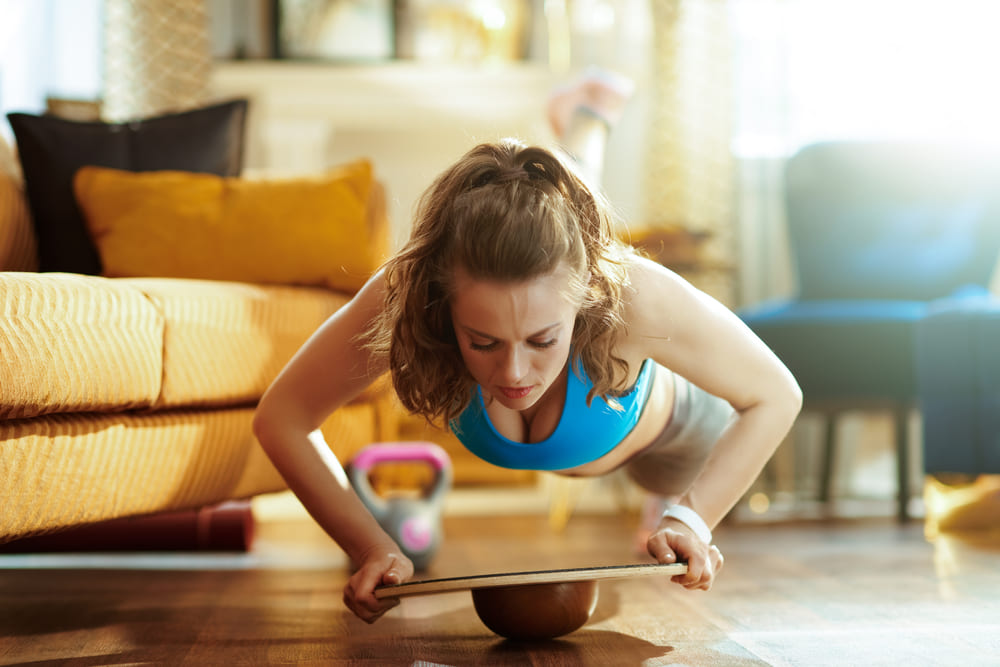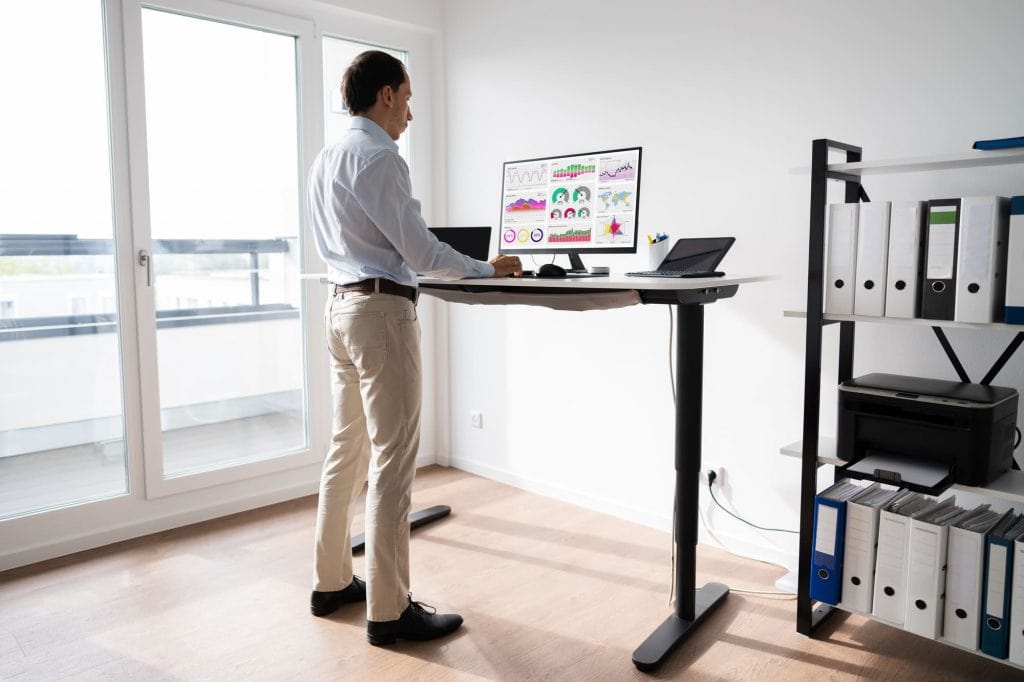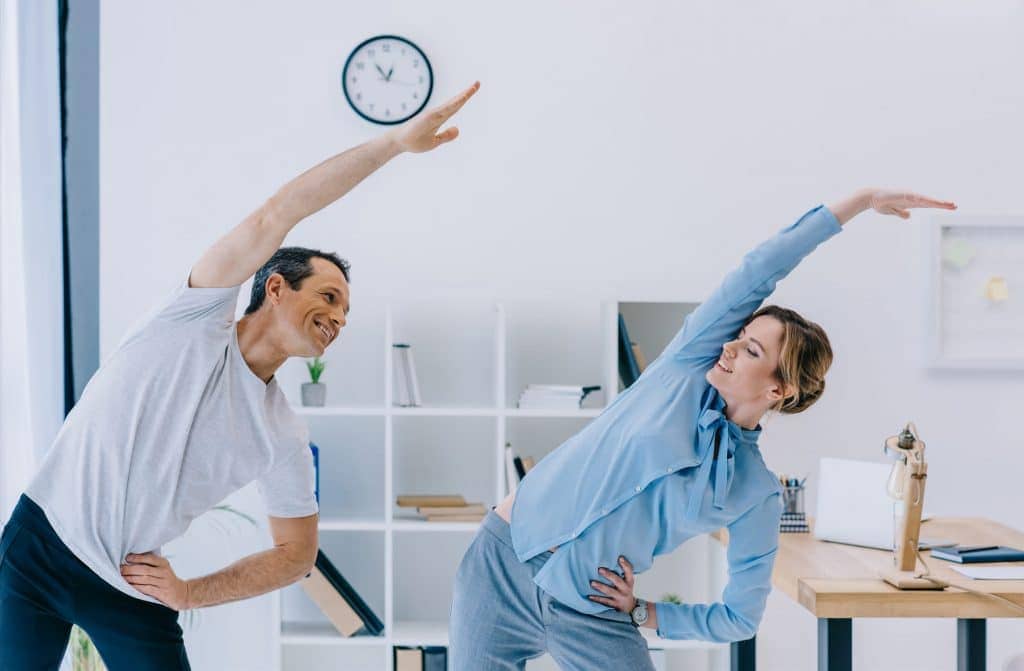*When you buy through links on our site, we may earn an affiliate commission at no additional cost to you.
You’ve probably already heard that the human body isn’t designed to sit all day long. Standing desks are a great tool to use at work to help you beat your sedentary habits.
But we’re also not meant to stay in the standing position for too long. They say that too much standing is just as bad as prolonged sitting.
And this is where the standing desk balance boards come in…
A good balance board is one of the best standing desk accessories that will keep you active by bringing more movements to your leg muscles—keeping your blood flowing. It will also help with posture, balance training, and coordination.
But first, you must learn how to use it properly to enjoy all these benefits.
Below, we’ll take you through a beginner-friendly step-by-step guide on using a balance board correctly while standing at your desk. We’ll also share some additional balance board exercises you can do on this accessory to stay active at work.
Table of Contents
Step-by-step guide on how to use a standing desk balance board:
Assuming you’re an absolute beginner in office balance board use, the following guide you through the basics of this accessory, from getting the right one to using it correctly.
Step 1. Choose the right balance board
The first step in using your balance board correctly is finding the right one. Though there are multiple types out there, not all of them are ideal for use in an office environment with a standing desk. Some are just too intense, while others will cause distractions in workplaces.
The office balance boards specifically designed for standing desk enthusiasts are the best option for you. They outshine other variations with better stability, offering space for movement and better aesthetics.
There are main types that work great for beginners using sit-stand desks. These include the rocker and wobble models.
Wobble boards: These boards let you move in all angles and directions (i.e., they support a 360-degree range of motion). They’re bowl-shaped at the center and help improve your sense of balance. The center acts as the only pivot, thus forcing you to maintain your stability on this point. Despite being a bit challenging to use, the benefits you get from the wobble boards will be well worth it. These boards are great for keeping fit and for physical therapy [1].
Rocker boards: These are the easiest to use of the two types of boards. This is because they have a limited range of motion, which means you don’t need a lot of focus and dedication to use them. They get their name from their front to back or side to side motion, depending on how you position your board. Rocker boards have a semi-circular base, unlike their wobble counterparts. With a rocker board, you’ll work out your core and leg muscles. it will also help you maintain a good posture while standing at your desk
These are beginner-friendly and will enable you to get the hang of them. They also come in varying sizes, so you can easily find the perfect balance board size that works for you.
After some time, you can move on to more challenging board variants such as roller boards to help engage more muscles and stay fit while you work.
Step 2. Wear the correct shoes
Another important thing you need to consider when using your new board is the type of shoe to wear. This is because the type of shoes you choose can significantly affect your balance and ability to use the board.

We advise you to go for flat shoes as they keep your toes and heels at the same level as the board. Your shoes also offer good traction to grip the board better and ensure your own safety.
Step 3. Mind the floor where you put your board
You’ll also need to ensure you place your board on a non-slippery floor so you don’t slide and fall. We suggest using the board on the carpeted floor where the chances of sliding are quite low.
Also, make sure your workspace is well lit and offers ample space for using your new board. If necessary, change your office layout to comfortably accommodate the board. This is necessary to prevent you from stumbling and falling.
TIP: Balance boards can damage hard flooring, e.g., wood. The contact board motion can cause your floor to wear over time. If this is a major concern for you, simply put a rug or carpet under it to minimize the damage.
Step 4. Keep it stable
Once you step on your board, you’ll need to keep it stable by evenly distributing your weight on it. You may also want to lean slightly on your toes or heels as necessary to maintain balance.
Step 5. Get in the correct posture
Besides evenly distributing your weight, you also need to position yourself on your board correctly to promote balance and stability. Align your hips, torso, and neck vertically (this should act as your center of mass).
Avoid looking at your feet when on the balance board. This will throw you off balance and cause you to wobble. Instead, focus your eyes on a point straight ahead and far away from you.
Step 6. Don’t use your board for too long
You should use your balance board for not more than 15 to 20 minutes. When using a height-adjustable standing desk, this timeframe will be easier to observe since you’ll be regularly switching between sitting and standing at regular intervals.
Top 5 Simple Exercises for balance boards
The best part about the balance board for standing desks is that it lets you exercise while working simultaneously. The following simple beginner exercises will help you stay fit at work.
#1. Push-ups
Assume the usual push-up position with your hands on the board. Put your hands on top of the board and keep the wrists in a fully-fledged position. This will help prevent your fingers from getting pinched while doing the push-ups.
If this is your first time exercising with the board, consider doing the push-ups while on your knees. Later on, when you get the hang of it, you can move to a greater challenge by doing full push-ups.
#2. Board tilt
This simple exercise will benefit you if you want to strengthen and stabilize your ankles. It works great with a half balance ball or wobble balance board.
Star from a natural position and tilt your balance board forward steadily until its edge touches the floor. Then, tilt it backward steadily until the edges touch the floor again.
Do this slowly for about 30 seconds. If possible, try tilting your board side to side (this will depend on the board you’re using).
If you lose balance when doing board tilts, use your secure sit-stand desk for support.
#3. Calf stretches
Stretching your calf muscles helps keep them from getting stiff while at the same time improving your stability.
To do balance board calf stretches, put your right or left foot on the board. Ensure the heel of this foot is flat on the board while the other foot stays flat on the floor.
From this stance, lean forward until you feel a stretch in your calf muscle.

#4. Round the clock
This exercise aims to keep your body steady as you make a complete rotation on your board.
Round the clock will help improve your balance skills and help strengthen your lower leg and core muscles as you try to control the movement. This exercise works perfectly with a half-balance ball or wobble board.
Starting from a neutral position, tilt your body forward steadily until its edges touch the floor. Now, rotate your board clockwise as the edges touch the floor.
Keep shifting your weight as you move until you make a full rotation. Now do a counterclockwise course.
Want to make this exercise more challenging? Try doing it with just one leg at a time.
#5. Squat
If you want to tone and strengthen more muscles simultaneously, including the quadriceps, hamstrings, and calves, try balance board squats. As an added benefit, this exercise will also help burn fat.
Stand on your board with your feet a bit wider than your hip-width and with the knee slightly bent. Now squat slowly, such that your thighs become parallel with the floor.
Hold this position for as long as possible, and then rise slowly. Try increasing the squat duration the next day to make this exercise more challenging.
Final Verdict
When you’re learning how to use a balance board for a standing desk for the first time, you should first understand the basics around it. This will enable you to use it correctly and get the most out of it and your standing desk.
We have already offered you a step-by-step guide on using a standing desk balance board. We have also discussed the right one to use as a beginner and some helpful balance board exercises you can do while on this board to stay fit at work.
Hopefully, you’re now fully equipped with everything you need to start using your balance board to lead an active office life.
Also read: How to choose the right standing desk.






